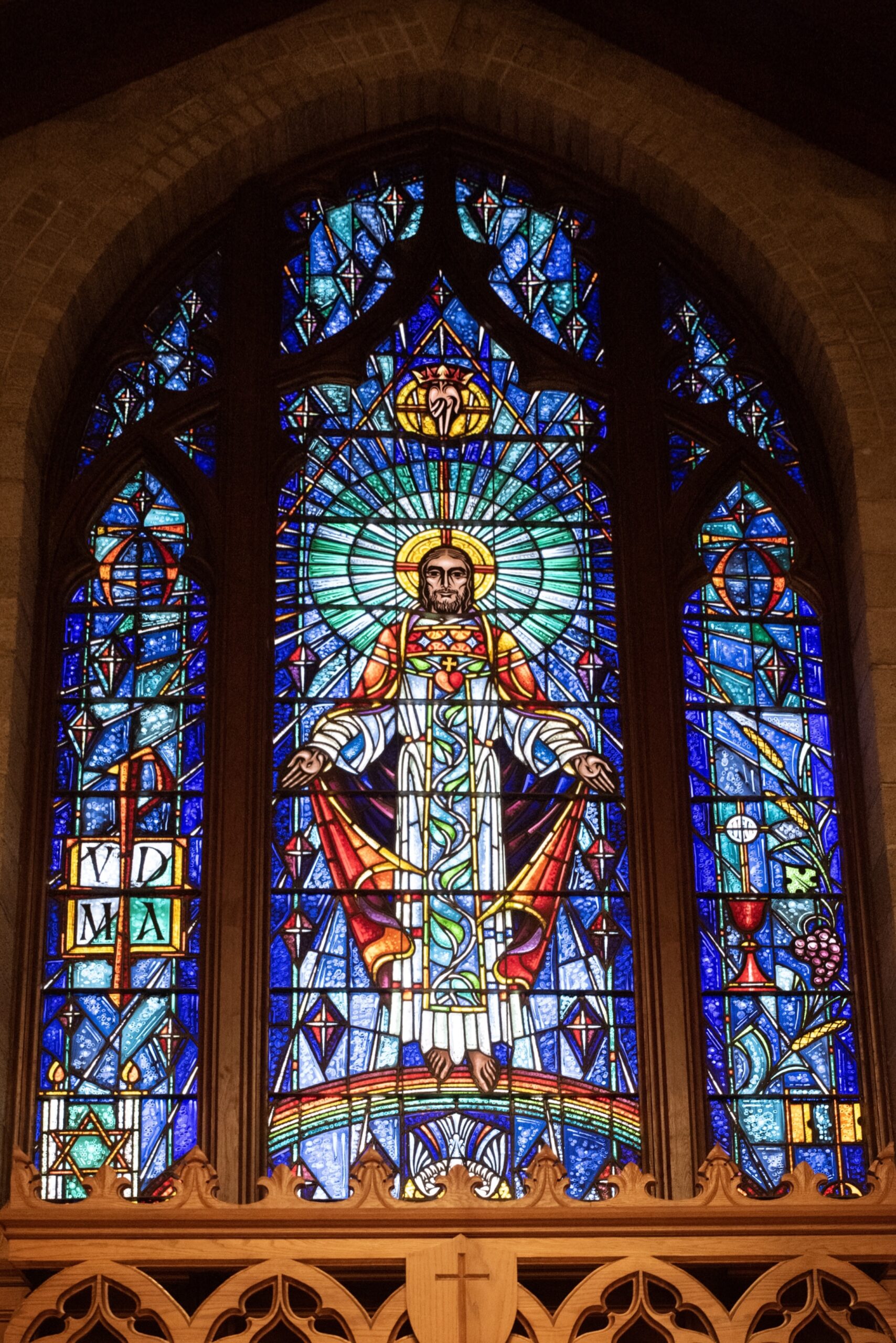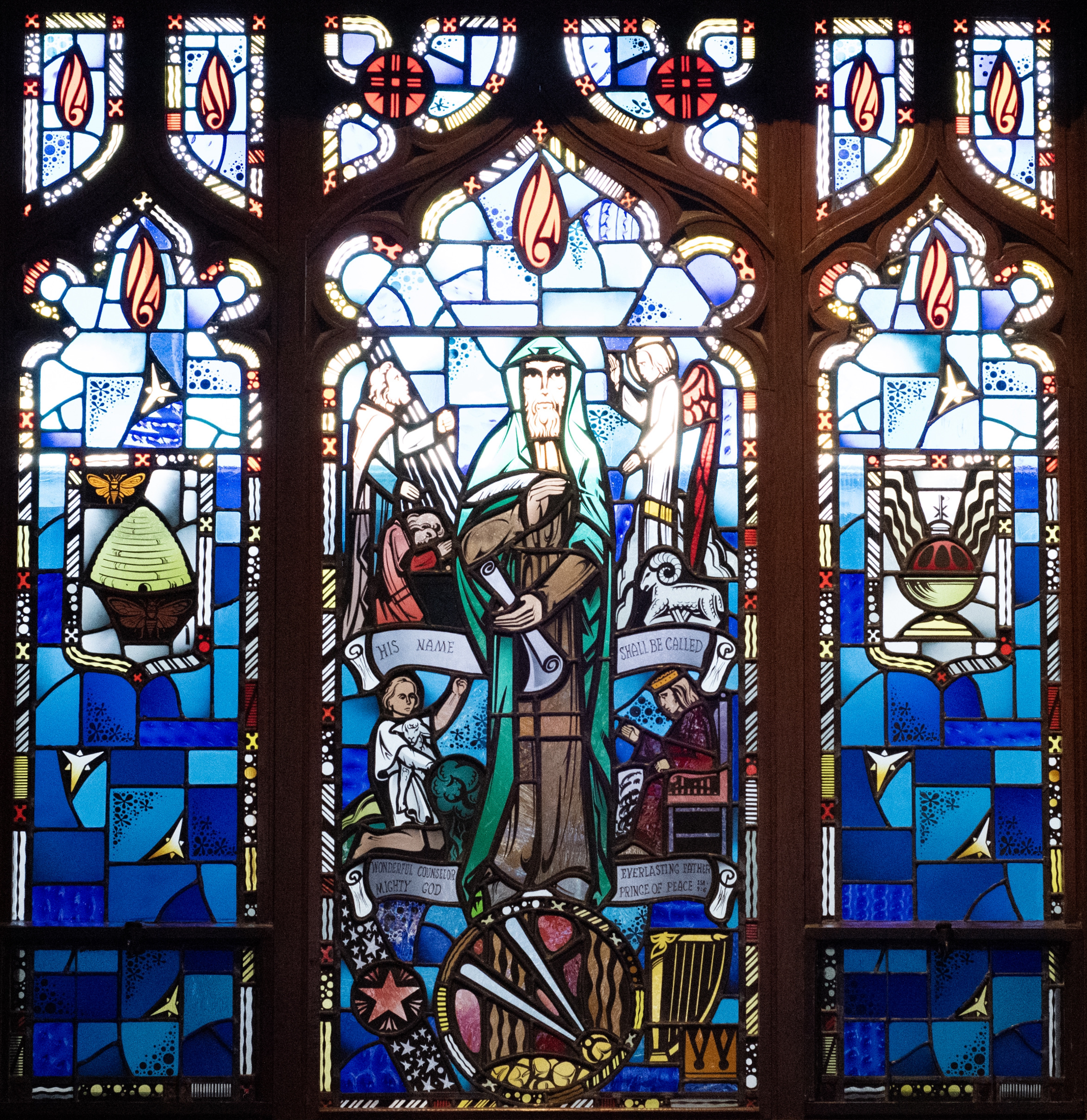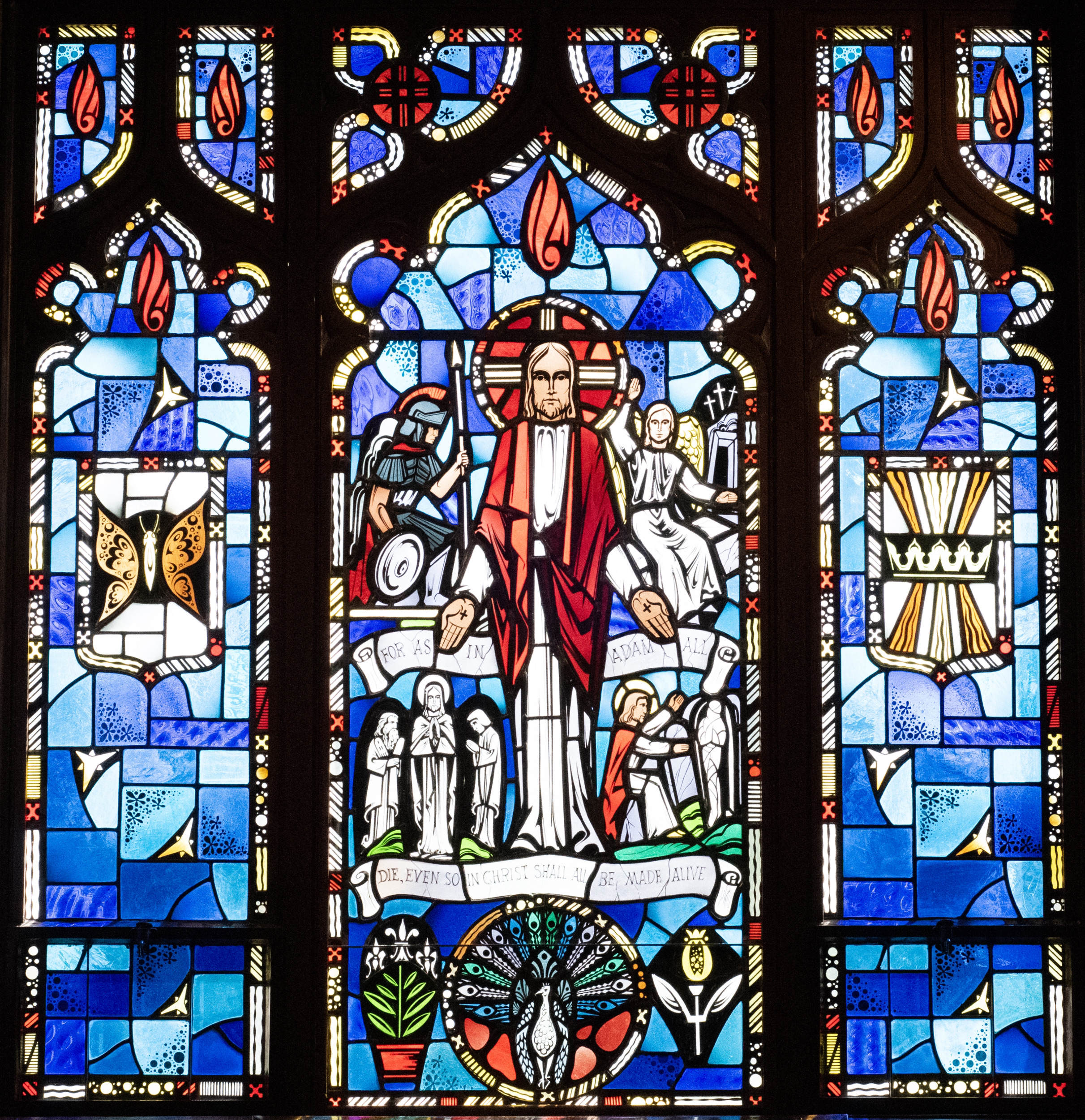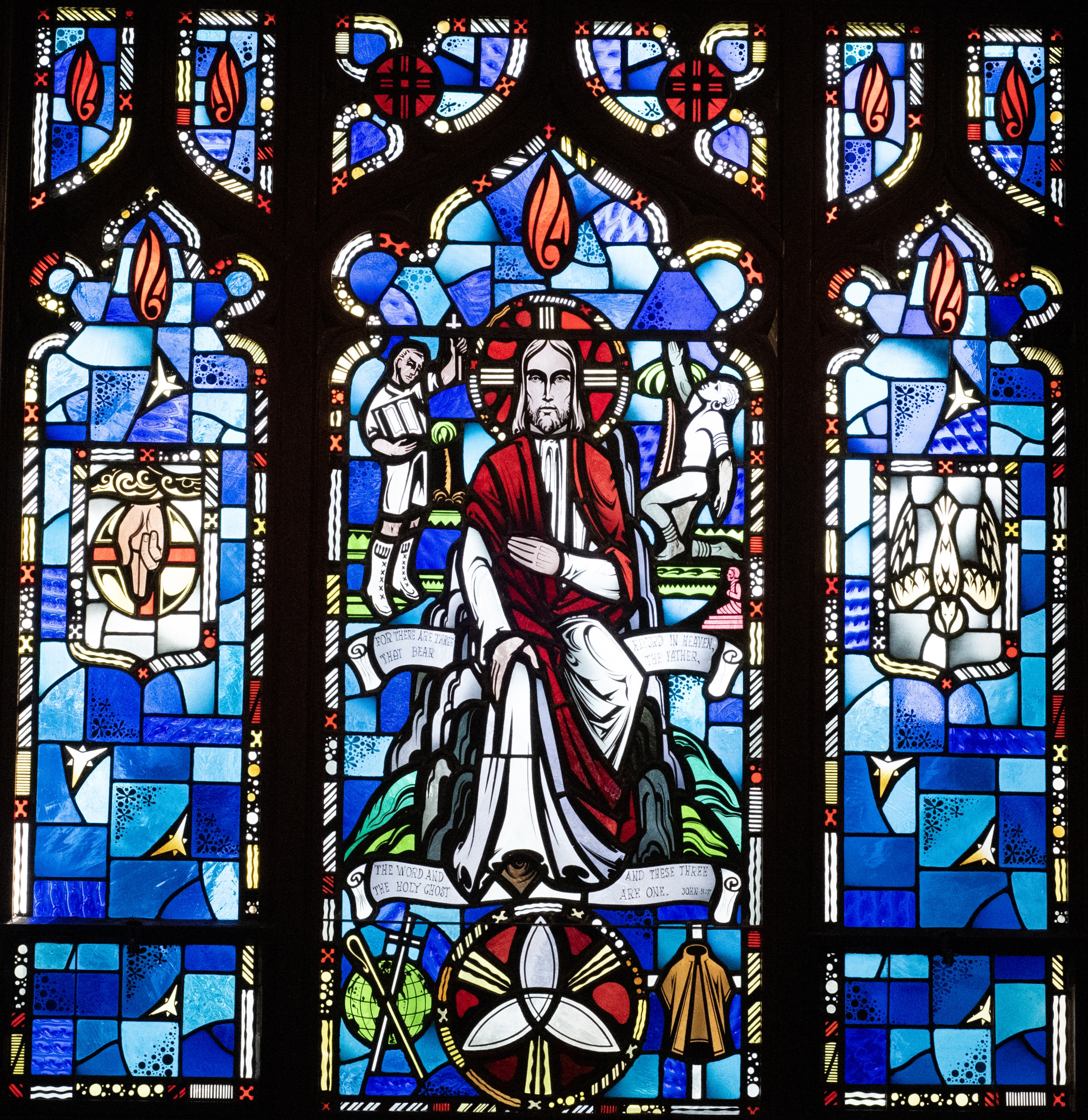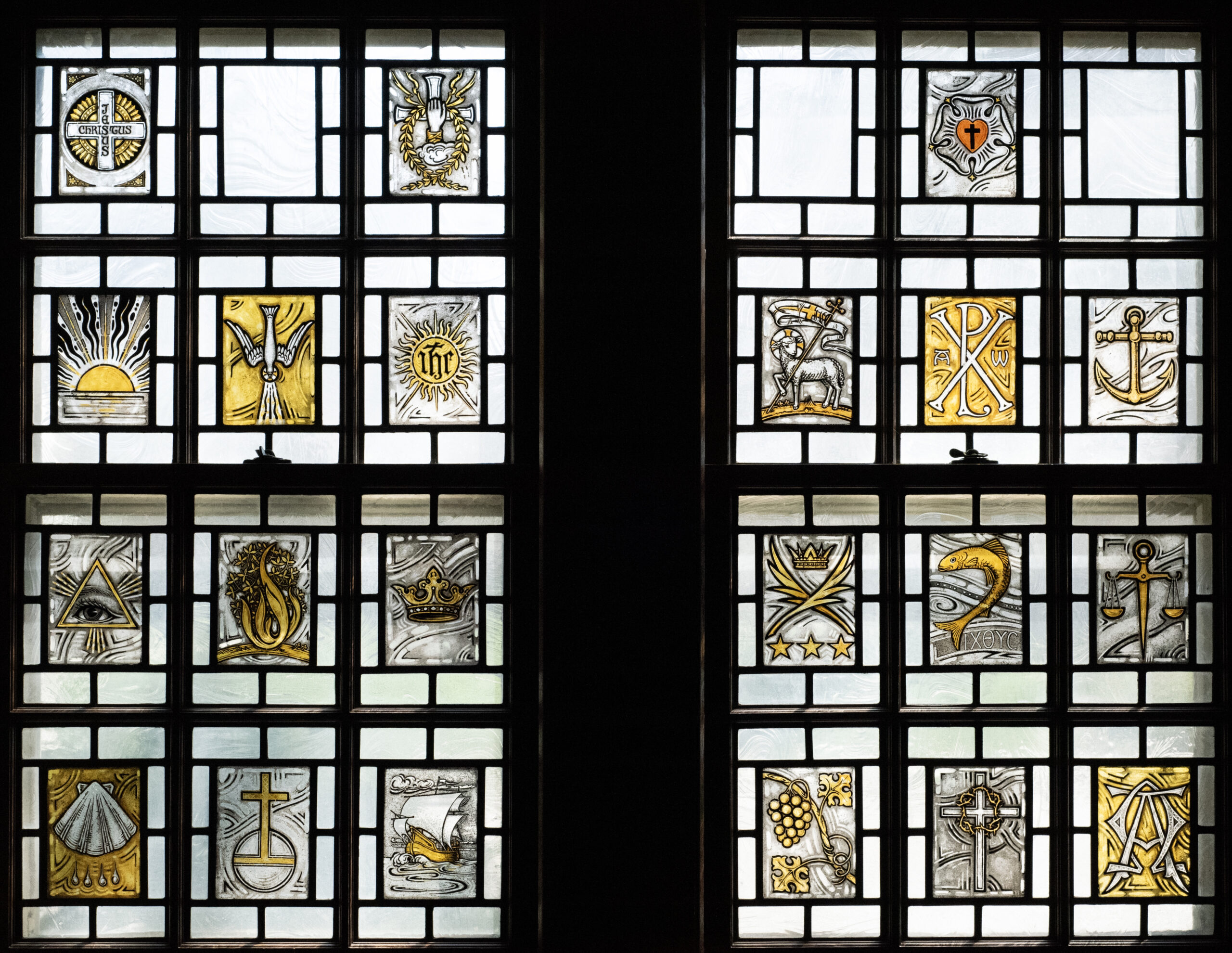Stained-Glass
The Windows of Diamond Lake
The stained-glass windows in the sanctuary of Diamond Lake Lutheran Church serve to enhance both the architecture of the building and the worship experience. The didactic, or storytelling, windows lining the cloistered side aisles were crafted in 1958 by Richard Heule, under the mentorship of Robert Berg. These windows depict scenes and symbols that narrate the Christian faith. Dominating the church’s interior, the chancel window stands as a testament to both faith and craftsmanship. Designed by Robert Berg and installed in 1952, it showcases Christ as the focal point of worship.
Altar Window
The large window at the front of the chancel is the Altar window. As the central focus of the Christian faith, Jesus Christ is the theme and foundation for all other symbols expressed in the stained-glass windows. Above Christ, the hand of God provides guidance, while below, a descending dove symbolizes the Holy Spirit. Encircled by a nimbus, these three elements symbolize the unity and essence of the Trinity.
Further emphasis of the Trinity is shown by the triangle that ties the three panels together. Jesus, dressed in regal robes, stands on a rainbow, symbolic of the covenant between God and man, and the center of the white robe depicts the “I am the vine and the branches” theme. The wounds on the outstretched hands and the bleeding heart speak of the fulfillment of God’s plan of redemption. The upper portions of the left and right panels contain, respectively, the Greek letters alpha and omega, representing the beginning and the end. VDMA (center left) is “Verbum Dei Manet (in) Acterm,” meaning “the Word of God remains forever.” Below this is shown the scroll of the law with the Star of David (the Talmud and the Torah), symbolic of God’s revealed plan for mankind’s redemption. In the lower right panel are the keys, the symbol of church authority. The two sacraments instituted by Christ, the Sacrament of Communion and the Sacrament of Baptism, are represented in the lower portion of the panel. The grapes and wheat are the source of the elements of the chalice and the host, and the dove represents the claiming of God’s children by the Holy Spirit. The entire window is scattered with stars representative of the true believers of God as based on God’s revelation to Abraham.
Prophecy Window
The first window on your left as you enter the sanctuary is referred to as the “Advent” or “Prophecy” window. The theme of this window is Isaiah 9:6 – “His Name shall be called Wonderful Counselor – Mighty God, Everlasting Father, Prince of Peace.” The central figure is that of Isaiah holding the quill pen and scroll of prophecy. In the upper left of the central panel, Abraham is portrayed in the act of sacrificing Isaac while the angel and ram are shown in the upper right. Immediately below this is David, depicted in the role of shepherd and king, with his lyre and kingly crown placed in the lower right portion of the panel.
There are both parallels and contrasts to note in this window, including the concept of sacrifice – Isaac in the Old Testament and Jesus in the New Testament – and promise. Abraham’s call and God’s promise to him are shown by many stars, with one star much larger and brighter than the others (signifying the Messiah), lower left portion. The circular symbol directly below Isaiah contains the coals, fire, and tongs of the sixth chapter of Isaiah.
The shield in the left panel shows honey and locusts representing John the Baptist, the direct forerunner of Jesus. The shield in the right panel contains an incense burner, a symbol of the ascent of prayer to God.
Nativity Window
The second window on the left is the Nativity window, depicting the birth of Jesus as set out in Luke 2:14. At the center of this window are the Madonna and Child, surrounded by angels, shepherds, and Joseph. The circular symbol (lower center) is symbolic of the nativity and contains the creche (cradle) with a Chi Rho symbol, an abbreviation of the Greek word for Christ: Χριστός. Sheep and lambs surround the circular symbol. The shield in the left panel contains the nativity star, the star of Bethlehem. The shield in the right panel contains the wisemen’s crowns and the shepherd’s staff.
Epiphany Window
The third window is the Epiphany window. The theme of this window is based on Luke 2:49, in which Jesus, as a boy of 12, attends the synagogue. He is surrounded by his parents and scholars. The circular symbol below Jesus contains the lamp of knowledge surmounted by a cross, symbolic of Christian truth. The history book, the staff of music (left), and the ball, bat, and glove (right), refer to Luke 2:52 – “And Jesus grew in wisdom and stature and in favor with God and man.”
The shield in the left panel is the scroll of prophecy. The right panel contains the symbol of confirmation – the shield of faith with the world – with an encircling cross superimposed upon the Chi Rho symbol; above, the dove, representing the Holy Spirit, extends rays of blessings.
Redemption Window
The fourth window located at the front of the nave on the left is the Redemption window. This window has as its theme John 1:29 – “Behold the Lamb of God, who takes away the sin of the world.”
The shield on the left contains the “law” of the Old Testament, while the shield on the right is New Testament “grace” as portrayed by the reclining, suffering lamb on the book of seven seals. The book of seven seals represents the power that was Christ’s alone to open the book of life, the path to salvation. Immediately beneath Jesus (circular symbol) is the alpha and the omega superimposed by a cross, showing that Christ is the beginning and the end (alpha and omega are the first and last letters of the Greek alphabet). To the left is the whip of thongs, representing the scourge of Jesus at the hands of the Roman soldiers, and the three nails. To the right is the red heart and white cross symbolic of grace. Both help to convey and portray the manner in which the character of God was imputed through suffering for sin to mankind. The other events depicted are scenes from Holy Week: the angel offering the cup to Jesus in Gethsemane; the road to Golgotha; and the three crosses of the crucifixion.
Resurrection Window
The story continues with the front window on the right side and it is known as the Resurrection window. Here is represented the risen Christ. Beneath his feet is the peacock, a common symbol of resurrection. When the peacock molts, he grows new feathers more brilliant than those he lost. The pomegranate (lower right) also symbolizes the resurrection as the hope of new life (split by the pressure of many seeds, signifying fecundity, this fruit possesses the power to reproduce life). The lily (left) shows that what once was a bulb decaying in the dark soil now produces a new bulb, stem, leaves, and flowers. The process of death and the release of new life are inseparable. The drama portrayed in the figures above represent: the healing of Lazarus, which began the Passion experience; Jesus, Moses, and Elijah on the Mount of Transfiguration, which opened new relationships of life and death; and the Roman soldier, the angel at the open tomb and the wounds in the form of crosses on Christ’s hands, snapshots of the crucifixion and resurrection.
The shield on the left contains a butterfly representing resurrection, in which the Christian spirit emerges into everlasting life. The three stages in the life of a butterfly represent three stages of the Christian’s life: the larva, the lowly condition of mortal man; the chrysalis in its cocoon, akin to the human body in the grave; and the pupa, which bursts its outer shell, dries its wings and soars heavenward with a beautiful new body.
The shield in the right panel contains a crown, used as a symbol of the kingly office of Christ and refers to eternal life.
Ascension Window
The second window from the front on the right side is the Ascension window. The theme of this window is taken from the portrayal of Jesus ascending into heaven in Luke 24:50-51. The angels in the upper left and right help to illustrate this, and the figures in the central portion of the window are representative of the disciples and those individuals to whom the risen Christ appeared. The flaming chariot of Elijah is contained in the circular symbol beneath the figure of Jesus.
The disciples are portrayed by eleven shields (note that Judas, Jesus’ betrayer, is not depicted here). Matthew’s three purses allude to his vocation as a tax collector. Three shells represent James’s pilgrimage and missionary journeying. John’s shield contains a chalice and serpent (the story goes that the priest of Diana attempted to kill him by giving him poisoned wine to drink, but he made the sign of the cross over it and the poison escaped in the form of a serpent). The shield containing an X-like cross depicts, according to legend, the form of cross that Andrew died on. Bartholomew’s shield shows three flaying knives, the supposed means of his death. Philip’s slender cross of two loaves of bread illustrates John 6:7. The saltier (crossed keys) in Peter’s shield refers to Peter’s confession and the authority vouchsafed to the Church given him in Matthew 16:18. Thomas’s shield shows a vertical spear and carpenter’s square (tradition says that Thomas, who went to East India as a missionary and built a church with his own hands, was shot with arrows and finally put to death by a spear at the hands of a pagan priest). James the Lesser is symbolized by a saw (according to tradition, James, at age 96, was thrown from the topmost portion of the temple and his body was sawn asunder). Simon (Zelotes) is depicted by a fish lying on a book, the fish indicating he was a “fisher of men” and the book signifying the Gospel. The shield for Jude (Thaddeus) is a small sailing ship symbolizing his missionary journeys.
The left panel contains an anchor. Its significance is based on Heb.6:18-19 – “The hope set before us; which we have as an anchor of the soul.” The right panel contains the Rose of Sharon, the symbol of Christ as fulfillment of the Messianic promise in Isaiah 35:1.
Pentecost Window
The third window on the right is the Pentecost window, based on the message in I Cor.12:13, that all people are one in the body of Christ. The left panel of this window contains a naus, historically a three- or four-masted sailing ship used by the Portuguese in the 15th century, suggesting that the ship of the Church has been tossed by the stormy waves of persecution, heresy, schisms, and false profits. The right panel contains the seven lamps (traditionally, the seven gifts enumerated in Rev. 5:12 as power, riches, wisdom, strength, honor, glory, and blessing), above which is the dove representing the Holy Spirit.
The entire window is representative of Pentecost, celebrating the Holy Spirit as the gift of God’s comfort, power, and strength. The central figure is that of Jesus with the dove (the Holy Spirit), surrounded by the church of true believers. The circular symbol beneath Jesus’s feet contains the flame in which the Holy Spirit is represented indirectly (Acts 2). The original Diamond Lake Lutheran Church building on the left and the present structure on the right serve to emphasize the growth possible through the work of the Spirit.
Trinity Window
The Trinity window, the last window on the right side of the nave, is based on John 5:7. It represents the culmination of the story of Christianity in the existence of three parts: the Father, the Son, and the Holy Spirit. The shield in the left panel has the providing hand of the Father. The center panel has, as its dominant figure, Jesus. The panel on the right contains the dove, the Holy Spirit.
The circular symbol below Jesus contains the “triquetra,” which is considered one of the most beautiful symbols of the Trinity. The three equal areas of the circle denote the equality of the three persons of the godhead. The lines run continuously, expressing their eternal existence, and are interwoven, which expresses their unity. The center forms an equilateral triangle, itself symbolic of the Trinity. Each pair of areas combine to form a nimbus, or halo, indicative of glory. It is a complex expression of equality, eternity, unity, and glory in what is essentially a simple form. Jesus is seated on a rock, a symbol of the Church. The man in the upper left is bringing Christ to others. The green palms and the red idol represent world missions. The cloak on the cross represents St. Martin of Tours (the symbol of healing and mercy), and the staff and cross in the lower left symbolize world missions. The entire window is representative of the ministry of the Word, the ministry of teaching, and the ministry of mercy and healing.
Clerestory Windows
The two small windows on each side of the chancel are known as the Clerestory windows. These windows are based on Isaiah 6. Each contains figures of angels, or seraphim, who hold shields depicting elements of worship: the harp for music/harmony; candles for adoration; folded hands for prayer; and palms for praise. Isaiah 6 states that the seraphim each had six wings: with two they covered their faces (in the glory of God’s presence), and with two they covered their feet, and with two they flew.
Narthex Windows
There are five stained glass windows in the narthex. Over 140 years old, they were salvaged from the old Bethesda Hospital in St. Paul and installed at Diamond Lake in 1968. These windows, which depict familiar Bible scenes in pictures, adhere to a more traditional design than that of the chancel and nave windows.
Beginning at the far left, we see Mary meeting Jesus in the garden at the tomb after the Resurrection. The next window shows Jesus as a counselor to a young man kneeling at his feet. The window in the center shows Jesus blessing the family as they sit at the table having devotions. Immediately to the right of the center is Jesus walking on the water to save Peter, who stepped out of the boat in faith and then began to sink when doubt overtook him. The last window is a picture of Jesus with arms outstretched, inviting everyone to “Come unto me.”
Meditation Room Windows
The windows in the Meditation Room, located just off the narthex, including 21 art glass medallions and stained glass windows mounted in a lighted wood frame, were preserved from the original Diamond Lake Lutheran Church chapel.
Revised in 2024 by Norma Williams. Originally written by Donna Peterson, a long-time member of Diamond Lake, who passed away in 1992. With gratitude to Judith Peacock for the preservation of the history of Diamond Lake Lutheran Church.

